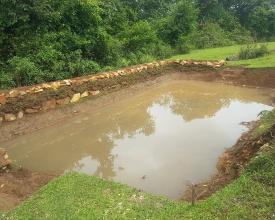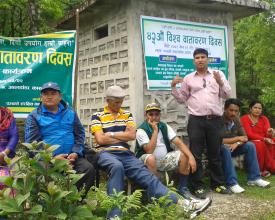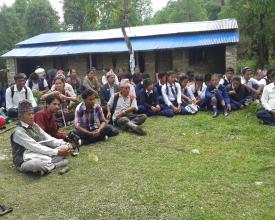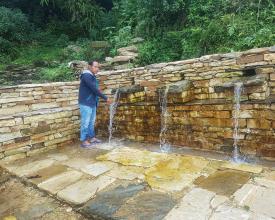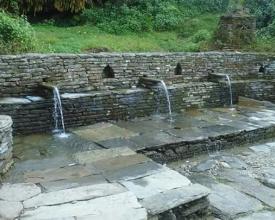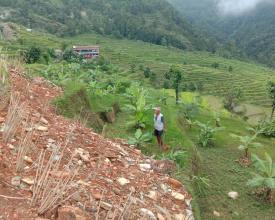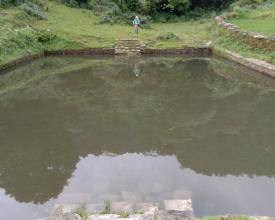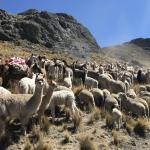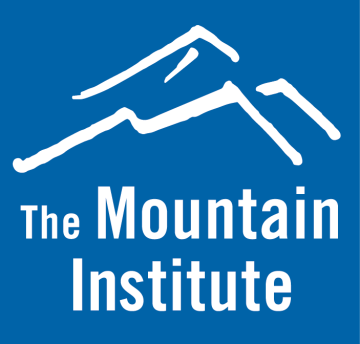
Utiliser les connaissances locales pour améliorer la disponibilité de l'eau à Panchase, au Népal
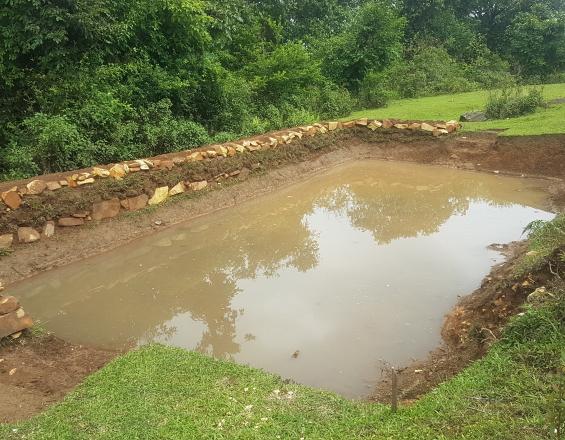
Traditionnellement, les habitants de la région de Panchase disposaient de sources d'eau naturelles, c'est-à-dire d'étangs et de sources d'eau qui fournissaient de l'eau à la communauté, aux voyageurs et aux animaux sauvages et domestiques. Ces zones naturelles offraient également des avantages écosystémiques, notamment la rétention et la régénération des eaux souterraines et l'habitat pour de nombreux types de plantes et d'animaux, y compris certains arbres ayant une signification religieuse pour la communauté. Ces dernières années, le développement a obstrué les sources d'eau de ces étangs et les sources naturelles ; dans certains cas, les étangs ont été construits. En utilisant des ressources locales telles que la boue, les pierres et l'ardoise, les membres de la communauté ont renforcé les berges des cours d'eau, enlevé les mauvaises herbes et les débris autour des sources d'eau. Ils ont également planté des végétaux à forte capacité de rétention d'eau et de sol. Ces mesures ont été conçues selon les principes de l'EbA, en mettant l'accent sur l'utilisation des ressources locales, l'intégration des connaissances locales et l'engagement de la population locale.
Contexte
Défis à relever
- Perturbation et endommagement de l'infrastructure traditionnelle des ressources en eau
- Sédimentation et glissements de terrain
- Pénuries d'eau dues à l'épuisement des ressources en eau
- Dégradation de la qualité de l'eau en raison de l'augmentation de l'activité anthropogénique à la périphérie des ressources en eau
- Pénurie de main-d'œuvre due à l'émigration des jeunes des villages
- Déconnexion et manque de coordination entre les organisations communautaires
- Perte de biodiversité due aux sécheresses
- Dégradation des zones humides due au pâturage en plein air
- Érosion pendant la saison de la mousson en raison de la mauvaise construction des routes et des pistes non planifiées. Des ruptures de pente peu profondes et des coulées de débris en résultent, entraînant la désintégration de l'écosystème aquatique.
- Faible sensibilisation à l'importance écologique, sociale et économique des ressources en eau.
Emplacement
Traiter
Résumé du processus
Les connaissances traditionnelles sur les méthodes permettant d'augmenter la rétention et l'infiltration de l'eau existent à Panchase sous la forme d'étangs et de sources d'eau. Cette mesure s'appuie sur trois piliers - la sensibilisation à l'EbA (I), la promotion de l'infrastructure verte (II) et la réduction du ruissellement de l'eau (III) - pour relever les défis liés à la disponibilité de l'eau auxquels la communauté est confrontée. Ces éléments se renforcent mutuellement, ce qui accroît l'efficacité et la durabilité. L'intégration des connaissances locales et scientifiques dans les modules I et II garantit l'autonomie de la communauté dans l'entretien des étangs et des sources d'eau. L'utilisation de matériaux disponibles localement renforce la confiance de la communauté dans sa capacité à financer et à entretenir la mesure. Le processus de hiérarchisation des sites de restauration facilite l'appropriation locale du projet, car les habitants se sentent habilités à apporter les changements qu'ils jugent les plus nécessaires. En outre, la signification religieuse des étangs et l'avantage social des espaces de repos communs constituent une motivation supplémentaire pour entretenir les étangs. Les blocs I et II créent un environnement propice à l'application efficace du troisième bloc, qui répond directement à un besoin existant et reconnu de la communauté.
Blocs de construction
Sensibilisation et connaissance de l'EbA
L'adaptation basée sur les écosystèmes (EbA) étant un concept totalement nouveau pour les parties prenantes et les communautés, il était essentiel de les sensibiliser à l'EbA et à ses avantages potentiels. Auparavant, le modèle de développement des communautés reposait sur la déforestation et la surexploitation des espèces végétales, ce qui avait un impact négatif sur la biodiversité. Une formation sur l'EbA a d'abord été dispensée aux organisations partenaires locales, puis aux membres de la communauté, en mettant l'accent sur la manière dont l'approche de l'EbA aborde le changement climatique et aide les communautés à traiter d'autres questions telles que la génération de revenus. Après les formations, une série d'activités de sensibilisation ont été menées, notamment la publication de brochures, de panneaux, d'affiches et d'autres supports. L'objectif était de montrer les différentes activités à mettre en œuvre, telles que la conservation des bassins d'eau communautaires, et leurs impacts positifs. Après avoir été sensibilisée au concept de l'EbA et à sa mise en pratique, la communauté a joué un rôle de premier plan dans la mise en œuvre des activités et a été habilitée à intégrer ses connaissances et compétences locales dans la conservation des sources d'eau et des étangs. Des experts techniques ont soutenu les connaissances locales des communautés en leur apportant une expertise technique et scientifique.
Facteurs favorables
- la participation active des organes directeurs, des agences de mise en œuvre, des communautés locales et des autres parties prenantes
- des outils de communication tels que des cartes interactives, des affiches et des vidéos
- Intégration des connaissances locales et des expériences passées en matière de construction d'étangs (type de matériaux, emplacements appropriés, etc.)
- Démonstration pratique des activités
- Promotion des scientifiques citoyens en tant que passerelles entre le projet et les communautés locales
- Les communautés dirigent la mise en œuvre
Leçon apprise
- L'engagement de la communauté est crucial. À Panchase, le projet a ciblé des dirigeants communautaires engagés qui, à leur tour, ont motivé d'autres membres de la communauté à participer.
- La participation de divers groupes augmente les chances de succès et la répartition équitable des bénéfices. Le projet a cherché à obtenir la participation de groupes d'utilisateurs de la forêt et d'autres groupes communautaires, y compris des groupes de mères, des groupes d'accueil et des groupes agricoles.
- L'équipe de projet doit bien comprendre le contexte environnemental, socio-économique et politique de la région. Le tourisme à Panchase a contribué à déterminer l'intervention. L'augmentation de la viabilité des homestays a fourni un point d'entrée pour des mesures supplémentaires.
- Le maintien de bonnes relations avec les communautés et les parties prenantes favorise la confiance. L'UICN et l'ONG locale ont régulièrement visité le site et les communautés et ont établi des relations solides grâce à des interactions positives fréquentes.
- Connaissances locales : le projet a utilisé les connaissances locales des communautés sur la restauration des étangs, la conservation et la gestion de l'eau pour développer l'intervention.
Promotion de l'infrastructure verte en utilisant les ressources locales
La première étape de cette mesure a consisté à collecter des informations sur les ressources en eau existantes, ainsi qu'à explorer le potentiel de nouvelles masses d'eau sur les sites. À l'aide de cartes, d'observations directes sur le terrain et de l'apport de la communauté, le projet a cartographié les différentes masses d'eau. En outre, les ressources ont été classées par ordre de priorité en fonction de la vulnérabilité du site, de l'étendue des dommages potentiels, de la possibilité de recharge des eaux souterraines, du risque de catastrophe induite par l'eau, du risque de pénurie d'eau et de la priorité pour les communautés. Après avoir établi des priorités, le projet a utilisé des ressources locales facilement disponibles pour réhabiliter les étangs et les sources d'eau. Le personnel du projet, le gouvernement local et les communautés ont appliqué leurs connaissances (traditionnelles et techniques) pour réhabiliter les étangs et les sources d'eau. L'utilisation de matériaux adaptés au contexte, disponibles localement et abordables (comme le bambou) a contribué à promouvoir la durabilité de l'intervention.
Facteurs favorables
- Établir la confiance au sein des communautés locales et entre les communautés et l'équipe du projet
- Le leadership actif des communautés et leur participation à la mise en œuvre des activités sont essentiels pour développer un sentiment d'appropriation du projet.
- Utilisation des connaissances et des ressources locales
- Contribution de la communauté en termes de main-d'œuvre
- Contribution financière du projet aux activités
- Promotion de l'infrastructure en fonction du degré de vulnérabilité et de la priorité accordée par la communauté
Leçon apprise
- L'intérêt et la participation de la communauté jouent un rôle clé dans la réussite de la mise en œuvre des activités.
- Une planification préalable avec des rôles et des responsabilités clairement définis contribue à la réussite de la mise en œuvre des activités.
- Il est plus efficace d'intégrer les connaissances locales aux connaissances scientifiques que d'appliquer une approche purement technique.
- Il est essentiel que les priorités des communautés soient respectées et intégrées dans la conception des mesures.
- Il est plus efficace de travailler avec des groupes qu'avec des individus.
- Le leadership de la communauté et la contribution de la main-d'œuvre à la construction de l'infrastructure créent une appropriation et un engagement au sein des communautés.
- L'utilisation des ressources locales pour promouvoir l'infrastructure verte est plus rentable, plus rapide et plus durable.
- L'intégration d'une variété d'activités complémentaires, telles que la plantation d'espèces qui favorisent la recharge en eau à la périphérie des infrastructures hydrauliques réhabilitées, est durable et efficace.
Réduire le ruissellement de l'eau
L'objectif de la restauration des sources d'eau, en particulier des étangs communautaires, est d'augmenter l'infiltration de l'eau en réduisant le taux et le volume du ruissellement pendant la saison des pluies et de stocker l'eau de pluie pour l'utiliser pendant la saison sèche. Le projet a soutenu la protection, la réparation et la réhabilitation des sources et des anciens étangs, améliorant ainsi l'approvisionnement en eau. Panchase reçoit un volume important de précipitations pendant la saison des pluies, de sorte que ces étangs stockent l'eau pour une utilisation ultérieure plutôt que de la laisser s'écouler. Cette eau est utilisée pendant la saison sèche pour irriguer les cultures et comme eau de boisson pour les animaux domestiques et sauvages. En réduisant le ruissellement, le projet a également réduit l'érosion des sols et les glissements de terrain dans la région. En outre, la mesure a augmenté l'infiltration de l'eau et contribué à la recharge des nappes phréatiques, ce qui profite aux zones situées en aval, ainsi qu'à l'ensemble de l'écosystème.
Facteurs favorables
- Connaissance technique de la restauration des sources d'eau avant d'engager les groupes communautaires dans la mise en œuvre des activités.
- Un rapport solide entre les communautés et l'équipe du projet
- Le projet s'est concentré sur l'élaboration de mesures visant à résoudre des questions déjà considérées comme problématiques par les communautés, ce qui a permis d'obtenir un fort soutien de la part de ces dernières en faveur des mesures.
- Les étangs ont été choisis pour être restaurés en fonction des priorités déterminées par les communautés elles-mêmes.
Utilisation des connaissances locales concernant l'emplacement des sources d'eau et l'utilisation des ressources
Leçon apprise
- L'utilisation d'une approche participative pour traiter les problèmes de la communauté garantit un plus grand intérêt et une meilleure appropriation des interventions du projet.
- Le fait de confier la responsabilité de la mise en œuvre du projet à des groupes communautaires accroît l'appropriation et l'engagement de la communauté, mais une formation technique et de gestion doit être dispensée avant le transfert de responsabilité.
- Des sources d'eau pérennes sont nécessaires pour assurer un approvisionnement en eau tout au long de l'année et donc une rétention d'eau efficace.
- Les interventions doivent être intégrées à d'autres activités pertinentes, telles que l'agriculture, afin de garantir la durabilité.
- Pour protéger les étangs communautaires des dommages causés par la construction de routes rurales, il est important d'appliquer des mesures de sauvegarde appropriées.
Impacts
Impact sur l'environnement
- Augmentation de l'infiltration de l'eau, réduction du taux et du volume d'écoulement de l'eau du bassin versant
- Réduction des catastrophes liées à l'eau, notamment l'érosion des sols et les glissements de terrain
- Contribution à la recharge des nappes phréatiques et à l'émergence d'eau en aval, en particulier pendant la saison sèche
- Amélioration de l'état des sols, principalement en raison de l'augmentation de leur teneur en eau
- Amélioration de la végétation, de la qualité de l'air, de la croissance des arbres et d'autres espèces à proximité des sources d'eau le long du bassin versant et dans la zone en aval
- Contribution à la conservation des écosystèmes aquatiques et terrestres
- Promotion d'un environnement sain
- Réduction de l'incidence des incendies de forêt
Impact social
- Motivation accrue pour s'engager dans des activités d'agriculture et d'élevage en raison de l'augmentation de la disponibilité de l'eau
- Création de possibilités d'irrigation et de culture d'espèces agroforestières, de cultures et de légumes de contre-saison, en particulier pendant la saison sèche
- Cohésion sociale accrue
- Renforcement de l'importance culturelle et religieuse locale des bassins d'eau et des aires de repos
- Réduction du risque de glissement de terrain pour les communautés locales
- Réduction des pertes dues aux incendies de forêt
Impact économique
- Contribution à l'écotourisme grâce à une beauté naturelle accrue
- Création d'emplois dans le domaine de l'agriculture et d'autres activités agricoles
- Contribution à la santé humaine et à la nutrition
- Augmentation des revenus des ménages
Bénéficiaires
- Direct : 500 ménages ruraux (environ 2500 personnes) vivant dans le sous-bassin hydrographique de Harpan Khola
- Indirectes : Communautés en amont et en aval de la forêt protégée de Panchase
Objectifs de développement durable
Histoire

Les habitants de Panchase dépendent traditionnellement des étangs appelés Pokhari pour leurs besoins en eau. Les Pokhari ont également une signification religieuse, et les arbres pipal(Ficus religiosa) étaient souvent plantés autour d'eux et vénérés. Traditionnellement, les communautés construisaient des aires de repos appelées chautari autour des étangs. Ils étaient souvent construits près des sentiers de randonnée, afin que les voyageurs puissent se reposer. Les villageois utilisaient les chautari pour leur bétail et comme lieu de rencontre communautaire. Les eaux des chautari sont également importantes pour certains festivals culturels tels que le festival chhat dans le Teraï et le bala chaturdasi dans les régions vallonnées du Népal.
Au cours de ses 70 années de vie, M. Guman Singh Gurung a été témoin de nombreux changements écologiques et socio-économiques dans sa communauté. Le village dispose désormais d'une route, de l'électricité, de l'eau courante, d'entreprises d'hébergement et de petits hôtels pour les touristes. Cependant, il y a également eu des changements négatifs. Les gens émigrent des villages et la plupart des terres agricoles sont abandonnées. Avec la dépendance croissante à l'égard de l'eau du robinet, les étangs ont été négligés. Nombre d'entre eux sont envahis par les mauvaises herbes et l'écoulement de l'eau vers d'autres est obstrué par la sédimentation due à la construction des routes. En outre, la modification du régime des précipitations, l'augmentation des températures, la diminution des ressources en eau et les espèces envahissantes nuisent à l'écosystème. Les changements climatiques et environnementaux importants ont affecté la disponibilité de l'eau et réduit la teneur en eau du sol, augmentant ainsi le risque d'incendies de forêt. La réhabilitation des étangs communautaires et des sources d'eau qui les remplissent contribue à résoudre les problèmes auxquels M. Gurung et d'autres membres de sa communauté sont confrontés.
Combinant science et connaissances locales, des experts techniques et des membres de la communauté ont travaillé ensemble pour restaurer les étangs, en utilisant des matériaux locaux tels que la pierre, l'ardoise, la boue et le bambou. Guman voit de nombreux avantages à l'augmentation de la disponibilité de l'eau, notamment une diversité de moyens de subsistance tels que l'agriculture hors saison. Ces mesures contribuent également à améliorer la recharge des nappes phréatiques, l'humidité du sol et la disponibilité de l'eau en aval et pendant la saison sèche, augmentant ainsi la capacité des communautés à s'adapter au changement climatique.

